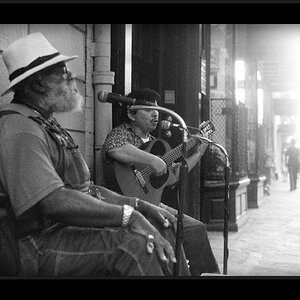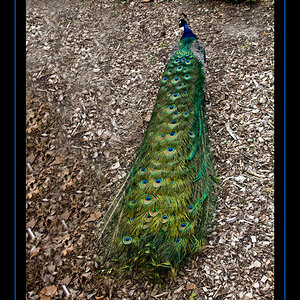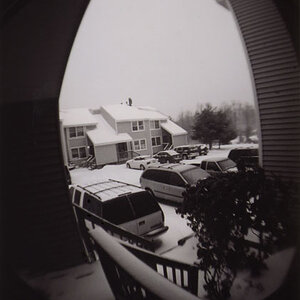Antithesis
No longer a newbie, moving up!
- Joined
- Aug 24, 2007
- Messages
- 1,340
- Reaction score
- 16
- Location
- Caribbean
- Website
- www.epanderson.com
- Can others edit my Photos
- Photos OK to edit
You shoot weddings with an E420 ?
No, I shot weddings with a 5D and a 20D, a 24-70L, a 70-200L and a bunch of primes. The e-420 is like my 8th dSLR, plus a few film SLR's before that. I bought it to travel with as I sold my 5D to pay rent after I got laid off from the studio I used to shoot for. Ironic I know.
The Oly is just a little travel camera and something cheap to keep me shooting until I finish school.
I think sticking to stringent compositional rules is just plain retarded. If everyone did that, then we wouldn't have any variety, just the same old crap.
Agreed until you change the word "rule" for that much nicer one "guidelines." What you call rules are not really so except for the noob. The noob (nothing bad intended here, btw, as we were all noobs once upon a time) has a lot to learn and having somewhat strict rules to deal with allows him to concentrate on what is more important, at first.
The rules allow him/her to come up with a decent photo if not a creative one. As the noob progresses, he/she can throw away all the rules and come up with his/her own vision. But you have to know the rules and know how to apply them before you can break them.
And you have to have a reason to break the rule before you break it. Just breaking a rule does not make you creative. Sorry. Every artist breaks the rules all the time but "I'm going to tilt this shot to be creative" is not creative. Actually, considering how many people are tilting their shots today, I would think it is more creative not to.
I've actually heard some pretty strong criticism of people like Ansel Adams for being so damn mathematical about his composition. I know that probably sounds dumb, but in my opinion the drama of the moment in his photos are more important than a perfectly horizontal horizon.
Lol at the skewed horizon. Most of the time someone mentions a skewed horizon, I need a ruler to see it and I had never heard so many people worried about horizons until I joined forums. That said, mentioning a name is dangerous. You like Adams, fine but I don't really. His photos are beautiful but they bore me to death. And I don't see the drama of the moment... 1/60th of a second in the life span of nature is like a speck of dust. No drama.
I've also had photography teachers tell me to add some tilt to photos, because it can often add drama to an otherwise boring shot.
Doesn't sound like a teacher I would want. Sounds to much like "well it did not work in color, let's make this B&W..."
And, working as a wedding photographer for almost a year, tilting your camera was the norm. Not in my work. If you had a good subject in front of you, you'd shoot a horizontal, portrait and everything in between, and often the angles in between will end up being the more interesting photos. Is it really or is it what the non-creative person (the client) sees as being creative? You can only arrange a bride and groom so many ways, or take so many dancing shots before it's time to tilt the camera and hope for some interesting photos. Are you sure it is not a case of your own creative limitation? I agree that there are only so many ways to arrange a bride and groom but do they really want to be arranged any other way? Maybe a wedding is not a time to be that creative. Maybe it is more a time to capture the event. I had the opportunity to think about this last summer when my son got married and the photos were extremely disappointing. Nothing wrong with them per say. Just your typical boring wedding photos which only my son and his bride will cherish.
Granted, there is a time and a place for everything. Amen to that
I'm just re-criticizing the people that insist that there can be no good way to tilt a camera. Certainly you shouldn't tilt every shot, just like you shouldn't shoot everything on a fisheye or cross process everything. Just because it's a trend, doesn't mean its not useful or compelling. The same way that HDR can be useful in producing some gorgeous landscapes.
"Maybe a wedding is not a time to be that creative. Maybe it is more a time to capture the event."
I think it's easy to do both. Many people also cherish gorgeous, fine art images that can be blown up to a 20x30 and put up on the wall. At the studio where I was formerly employed, it was pretty standard for people to purchase numerous large prints to frame on top of their albums. I'm pretty sure these wouldn't sell if you were shooting strictly documentary photographs. Images with differing compositions can also be used to add variety to an album, while still covering the documentary side of things.
And many clients chose our studio strictly because we were very creative. And because of that we ended up with the highest paying clients in our neck of the woods, and often outside of it.
Also, much of your statement is saying that it's not creative to do this or that, and criticizing something because it's a trend. Following that thought process would totally do away with the rule of thirds or any other compositional "guidelines". They are all just additional tools to help us compose a shot when we are at creative odds with a subject. I don't think any of us have the right to really tell anyone that they are composing an image "wrong", even if they are imitating someone else.
Oh, and look at Adams' "Clearing Winter Storm" and tell me that's not dramatic. It's my favorite photo from any artist for that very reason.
Last edited:






![[No title]](/data/xfmg/thumbnail/30/30876-d35f95603398bf3423b26c68d344f018.jpg?1619734492)



![[No title]](/data/xfmg/thumbnail/35/35597-714b74cc48992e5353856abfe325df68.jpg?1619737065)

![[No title]](/data/xfmg/thumbnail/40/40310-01bec1b9b7918522bf21a09cf75c5266.jpg?1619739414)

